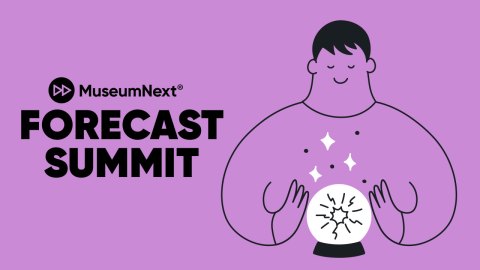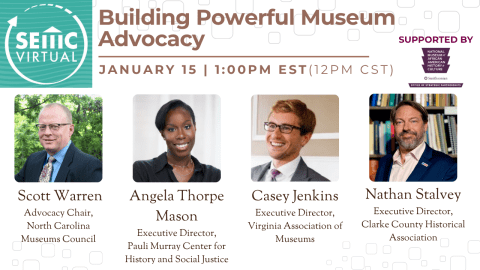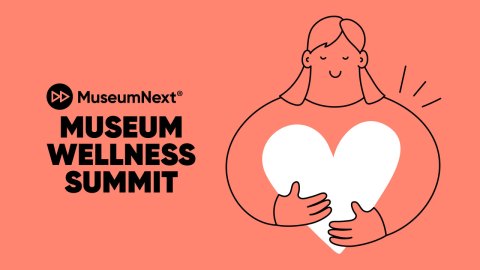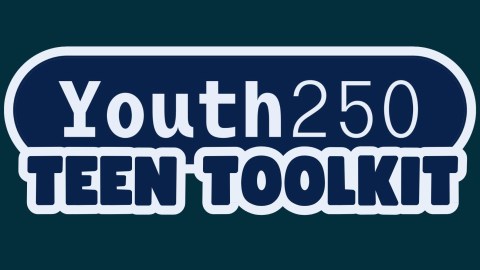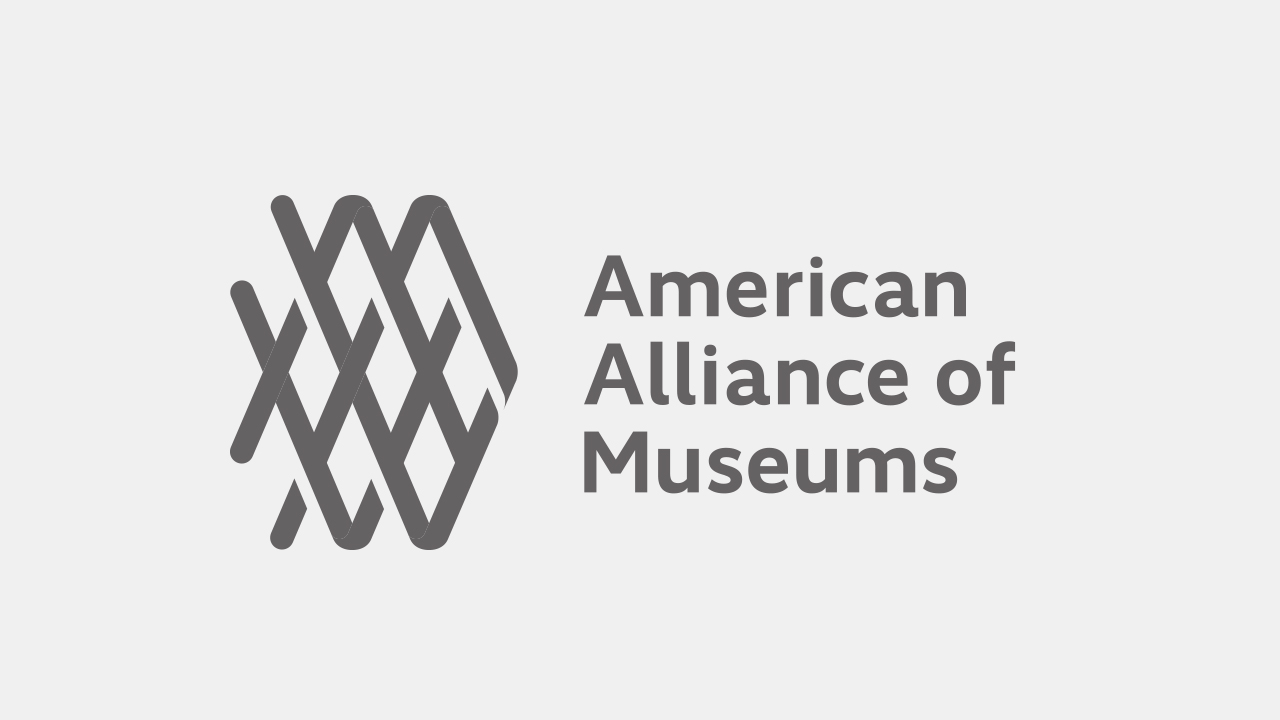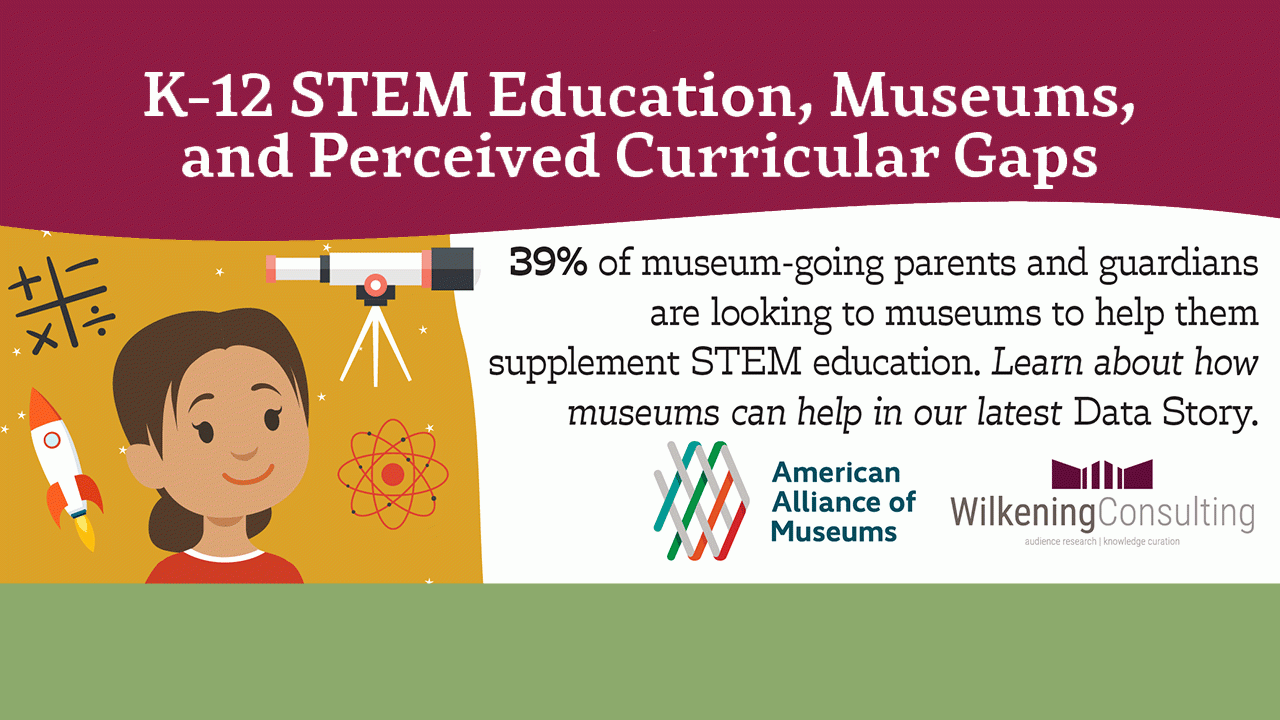
This visual Data Story is based on findings from the 2025 Annual Survey of Museum-Goers, a national survey of American museum visitors from AAM and Wilkening Consulting. Every year, the survey partners with individual museums to research their audiences and yield insights about their behaviors and preferences, both on an institutional and national level. (Learn more about the purpose and methodology of the survey here.) Interested in joining the 2026 edition? Sign up by December 1 to unlock a special early bird rate!


Parents and guardians have always been concerned that their children are receiving a well-rounded education, ranging from the arts to history to STEM subjects … the very subjects museums excel at sharing.
As schools struggle to pack more content into the same number of hours, and often with limited resources, we’ve been asking parents and guardians of school-age children about how museums can help them supplement formal education. Last year we shared what they said about K-12 history education.¹ This year, we focused on STEM. In 2026, we’ll be focusing on art education!
First, parents and guardians of school-age children were asked what types of schools their children attended. They could choose more than one, since siblings could be in different types of educational environments. Here’s what we found:
- Public school: 72%
- Charter school: 7%
- Private school: 19%
- Homeschool²: 10%
Those who chose public, charter, or private schools then received a question asking if they deliberately visited museums to fill in gaps they didn’t feel their child’s school covered adequately, asking about art, STEM, and history education specifically.
In 2024, those three disciplines posted similar numbers, while a third of parents said no, they were happy with the school curriculum. But in 2025, slightly fewer parents and guardians were supplementing STEM curriculum, slightly more were supplementing art curriculum, and there was more significant growth among those supplementing history curriculum. (We’re curious how this will play out in 2026, given political pressures on history content in particular.)
- Art education
- 2024: 47%
- 2025: 49%
- STEM education
- 2024: 41%
- 2025: 39%
- History education
- 2024: 44%
- 2025: 48%
- No, I’ve been happy with what schools are doing
- 2024: 34%
- 2025: 33%
Overall, those who were happy with schools were more likely to have younger children (more in the K–2 range), so they likely were not perceiving curriculum gaps … yet.
Respondents who chose art and history were more likely to have children in middle and high school, when those curricular gaps become most obvious.
For this Data Story, we are looking at respondents who said they were supplementing STEM content. These respondents were more likely to have elementary-age children, with fewer parents and guardians of teens saying they visit museums for STEM content. Overall, this suggests that parents and guardians of older children are not finding that the science content in museums is fitting their child’s curricular needs effectively, presenting an opportunity for science museums to consider.
There was one last question, however, that was only seen by parents and guardians who explicitly said they were seeking out STEM experiences. We asked:
Thinking of STEM education specifically, what kind of STEM content do you want museums and science centers to share? What do you think is missing or needs addressing from what is taught in your child’s classroom?
We then hand-coded every single written-in response to this question, nearly 1,400.
Less than 10% of written-in respondents specifically addressed STEM curriculum in schools, but those that did mostly lamented that schools didn’t have the time or resources to go explore STEM adequately.
“Broader array of STEM topics that are not covered in school due to the limited school resources funding.”
Instead, most respondents focused on their STEM needs … or said “yes, but what about …” Responses fell into four main categories.
1. Museum-Focused
A majority of responses fell into one of these categories, which focused on what respondents felt museums did best, including:
A desire for more STEM content, whether they asked for a general “more” or had specific topics they wanted their children exposed to.
“The more STEM content the better!”
By far the most common request, however, was for more hands-on, immersive experiences that schools simply cannot provide … and if this catalyzed an interest in STEM by making it fun and exciting, even better.
“Must be hands on and relevant to a child’s daily life or as close to magic as possible. Whimsy and mystery draw the child’s mind in and open to learning. They must be fascinated for learning to be facilitated.”
2. Pragmatic
These respondents were more focused on applying STEM in practical ways to everyday life, and they were also about 50% more likely to have middle or high-school age children. Their pragmatism towards STEM may be rooted in the transitions their older children are making as they think about their futures, including:
Applicability or relevance to daily lives and the real world.
“Real life problems and issues should be used. Often in the classroom there are concepts used as examples to learn, but applying real life situations may be more helpful in the way students explore, learn, and try things.”
The kinds of jobs and careers that can be found in STEM.
“A more immersive experience such as realistic research labs – what is [it] like to be an archeologist, geologist, etc. Basically, more in-depth real life scenarios.”
3. Mind-set/process
A smaller group of respondents thought more about the hows and whys of STEM. This came out in their mind-set and a process-based orientation.
What do we mean by that? For these respondents, it was an open-minded approach to looking at the world. Thus, they talked about sparking curiosity and developing critical thinking as fundamental for approaching STEM concepts, innovation, and learning.
“Reinforcing the methodologies of solving problems and the importance of thinking outside the box.”
And as part of that, there was also an articulation of the scientific method as being a tried-and-true methodology of scientific process that was important for evidence-based learning with credibility and trust. While the percentage that referred to the scientific process was one of our smallest groups, they spoke with passion. And it was one of the few themes we identified that skewed politically: liberals were three times more likely to talk about this than conservatives.
“With some attacks on evolution and climate science in school curricula, reinforcement of fact-based evidence on those topics surely belongs in museums.”
4. Yes, but what about …
These respondents cared about STEM … after all, their answers got them to this question in the first place! But when they reached this open-ended question, their responses indicated that while they valued STEM, there were other topics that were even more important to them.
Such as the arts and humanities. These respondents articulated that STEAM (to include arts) was more desirable, that STEM receives more attention in schools than art and history, and/or that history, of all subjects, is the most neglected of all.
“Without art, there is often no science and without science, there is no art. Art drives creativeness and imagination and innovation. Art and science and education allows critical thinking and self-awareness. Any STEAM integrated into museums, collaborating art and science, should link all aspects of learning (math, science, history, etc.).”
Similarly, a small group of respondents said yes to STEM, but their bigger yes was to inclusion. Their comments explicitly asked for science museums to include women and scientists of color in their exhibitions and programs, so that all children could feel represented in STEM, and could see themselves with futures in STEM. Interestingly, there was not a significant political skew to these comments: liberals were only slightly more likely to mention this than moderates or conservatives.
“I want to see more women of color being highlighted so when I take my daughter, she becomes more motivated and knows her wild dreams are attainable.”
What about politics?
Interestingly, comments were largely apolitical. For the most part, there were no significant differences between liberal and conservative parents and guardians in how they responded to this question (we noted the two exceptions above) and overtly political responses were scarce.
Keep in mind, however, that the survey was in the field from January to early April. Political shifts affecting science and science research in particular was ramping up during that period, but many respondents answered these questions before the change in administration or during its first few weeks (before the scope of the shifts were becoming broadly clear). If we had fielded this survey in the fall of 2025, results might have been more political.
That said, when we fielded a similar line of inquiry on history in 2024, before the change in administration, nearly half of respondents did touch on politics or politicization of content, indicating that history has been on the front-lines of the political culture wars much more intensely over the past few years. We’ll continue to monitor these shifts, as we wouldn’t be surprised to find increased politicization of STEM in future surveys.
Overall, however, our results indicate that most museum-going parents and guardians want their children exposed to STEM subjects, and consider museums their partners in supplementing and expanding upon what schools are able to do. And as our world, and humanity, continues to be deeply affected by scientific and technological changes, thoughtful and accurate explorations of those very topics will be needed by the public more than ever. Not just for our students, but for all of us.
“Our schools do a great job, but I feel that my job as a parent is to provide him with every opportunity to learn and be exposed to all sorts of ideas. Life is learning and learning is life.”
Annual Survey of Museum-Goers Data Stories are created by Wilkening Consulting on behalf of the American Alliance of Museums. Sources include:
- 2025 Annual Survey of Museum-Goers, n = 98,904; 202 museums participating
- 2025 Broader Population Sampling, n = 2,079
- 2017 – 2024 Annual Surveys of Museum-Goers
*Data Stories share research about both frequent museum-goers (typically visit multiple museums each year) and the broader population (including casual, sporadic, and non-visitors to museums). See the Purpose and Methodology (Update) Data Story from September 11, 2025 for more information on methodology.
¹ See our Data Story “K–12 History Education, Museums, and Perceived Curricular Gaps,” October 31, 2024
² See our Data Story “Homeschool Families,” November 7, 2024, for more information
More Data Stories can be found at https://wilkeningconsulting.com/data-stories/.
© 2025 Wilkening Consulting, LLC

